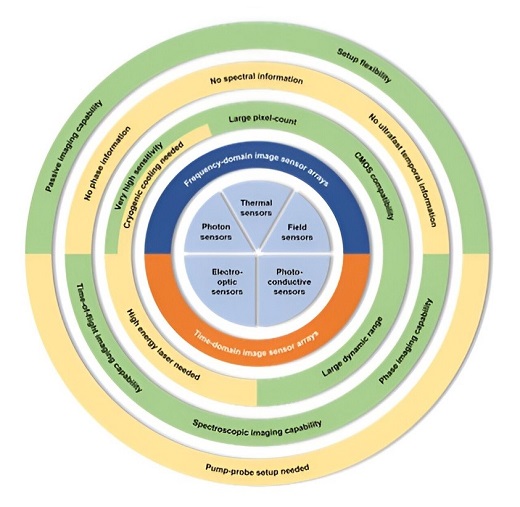by Chinese Academy of Sciences

Summary of functionalities and limitations of different terahertz imaging systems based on image sensor arrays. Credit: Mona Jarrahi
Lying between the infrared and millimeter wave regimes, terahertz waves possess many unique properties, prompting numerous compelling imaging applications, such as non-destructive testing, security screening, biomedical diagnosis, cultural heritage conservation, chemical identification, material characterization, and atmospheric/astrophysics studies. However, many existing terahertz imaging systems require imaging times ranging from tens of minutes to tens of hours due to their single-pixel nature and the requirement for raster-scanning to acquire the image data.
To realize the full potential of terahertz imaging for real-world applications, the lengthy imaging process of traditional systems is gradually addressed by the development of terahertz image sensor arrays and advanced computational imaging algorithms.
In a new paper published in Light Science & Application, a team of scientists, led by Professor Mona Jarrahi and Professor Aydogan Ozcan from the University of California Los Angeles (UCLA), review the recent developments in high-throughput terahertz imaging systems from both hardware and computational imaging perspectives.
They introduce various image sensor arrays that have been utilized to develop high-throughput frequency-domain and time-domain terahertz imaging systems. In the frequency-domain category, the single-frequency or frequency-averaged response of the imaged object is captured. Various types of sensor arrays used in frequency-domain terahertz imaging systems include image sensor arrays based on microbolometers, field-effect transistors, photon sensors, and superconducting sensors.
In the time-domain category, the ultrafast temporal response of the imaged object in response to a pulsed terahertz illumination is captured, which provides not only the amplitude and phase, but also the ultrafast temporal and spectral information. Two major types of raster-scan-free terahertz time-domain imaging systems are reviewed: one based on electro-optic sampling with an optical camera, and the other based on photoconductive antenna arrays. The functionalities and limitations of frequency-domain and time-domain terahertz imaging systems are compared and possible modifications of existing imaging systems to achieve new/enhanced capabilities are discussed.
Alongside the rapid developments in terahertz imaging hardware, computational imaging methods have provided additional functionalities, easing some of the restrictions of terahertz image sensors for high-throughput operation. The authors discuss three major computational imaging methods: digital holography, spatial encoding, and diffractive processing. Digital holography can realize terahertz phase imaging with frequency-domain image sensors.
Spatial encoding of the terahertz beam detected by a single-pixel imaging system can enable image reconstruction by computational methods such as compressive sensing algorithms. Diffractive processing engineers the terahertz front-end for task-specific beam encoding, taking over some of the computational tasks typically handled by the digital back-end. Diffractive deep neural networks (D2NNs) can collectively perform a complex function between the input and output fields-of-view using light-matter interaction and achieve various imaging tasks, such as object classification, imaging through diffusers and quantitative phase imaging.
The authors hope this review can inspire further developments in the terahertz imaging science and technology and accelerate wider utilization of terahertz imaging systems not only in scientific laboratories and industrial settings, but also in our daily lives.

